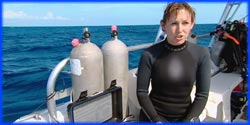


Premier Date: November 30, 2011
confirmed
Adam and Jamie decided to test three facets of the myth: time to get off the toilet and into the tub, effectiveness of the liquid nitrogen in delaying the trigger, and ability of the blanket and tub to shield its occupants. After building a replica of the movie bathroom and incorporating all details of the scene, including a prolonged time spent sitting on the toilet, Adam was able to pull Jamie into the tub and under the blanket in 1.95 seconds.
On the bomb range, they set up a charge of C-4 and a high-speed camera to measure the delay between triggering and detonation. A control run with an ambient-temperature bomb gave a delay of 3.3 milliseconds, while pouring the liquid nitrogen directly onto the charge increased it to 15 milliseconds. When the liquid nitrogen was poured over both the charge and the battery powering the trigger, the bomb would not detonate at all until the entire rig had warmed up to ambient temperature, 15 minutes later. Adam and Jamie commented that the technique was actually more effective in real life than in the film; the characters could have simply stood up and walked out of the bathroom.
To test the third part of the myth, they built a bathroom set with a heavy cast-iron tub as seen in the film, put Buster in the tub under a blanket, and fitted the tub with sensors to measure the pressure inside and outside. When a 1 kg charge of C-4 was set off under the toilet, the entire set was destroyed except for the tub. The peak pressure outside the tub was a lethal 180 psi (1.2 MPa), while the inside sensor recorded 8 psi (55 kPa), meaning that a person would survive but have some chance of suffering hearing damage. Adam and Jamie declared the myth confirmed.
confirmed
While visiting a bird sanctuary, Kari and Tory learned the reason for the birds’ V-formation: air vortices from the leading birds’ wings allow the trailing ones to flap less often and less vigorously. Kari then built some model airplanes, which she and Grant took for testing in a NASA water chamber. With three planes in a V, they saw vortices at the lead plane’s wingtips that persisted for a large distance behind it.
At Tracy Municipal Airport, the Build Team met with a 9-member acrobatic flight club to test out different flying formation: V, wingtip to wingtip, single file, and a control run with no formation. A tight V reduced fuel consumption by 3-5% compared to the control, while the other two formations either gave no reduction or increased the fuel usage. The team declared the myth confirmed at this point, but noted that the close formation could pose a danger to the pilots. A second run, with the planes spaced farther apart, gave a fuel savings for only Tory due to the difficulty of staying in the lead planes’ vortices. Nevertheless, the team commented that even a small fuel savings could lead to a sizable financial advantage at a large scale.
Previous: Episode 177: Wheel of Mythfortune